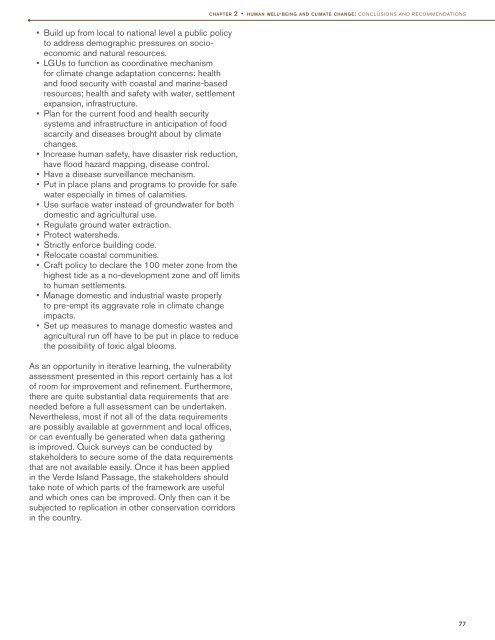of the Verde Island Passage, Philippines - weADAPT
of the Verde Island Passage, Philippines - weADAPT
of the Verde Island Passage, Philippines - weADAPT
You also want an ePaper? Increase the reach of your titles
YUMPU automatically turns print PDFs into web optimized ePapers that Google loves.
• Build up from local to national level a public policy<br />
to address demographic pressures on socioeconomic<br />
and natural resources.<br />
• LGUs to function as coordinative mechanism<br />
for climate change adaptation concerns: health<br />
and food security with coastal and marine-based<br />
resources; health and safety with water, settlement<br />
expansion, infrastructure.<br />
• Plan for <strong>the</strong> current food and health security<br />
systems and infrastructure in anticipation <strong>of</strong> food<br />
scarcity and diseases brought about by climate<br />
changes.<br />
• Increase human safety, have disaster risk reduction,<br />
have flood hazard mapping, disease control.<br />
• Have a disease surveillance mechanism.<br />
• Put in place plans and programs to provide for safe<br />
water especially in times <strong>of</strong> calamities.<br />
• Use surface water instead <strong>of</strong> groundwater for both<br />
domestic and agricultural use.<br />
• Regulate ground water extraction.<br />
• Protect watersheds.<br />
• Strictly enforce building code.<br />
• Relocate coastal communities.<br />
• Craft policy to declare <strong>the</strong> 100 meter zone from <strong>the</strong><br />
highest tide as a no-development zone and <strong>of</strong>f limits<br />
to human settlements.<br />
• Manage domestic and industrial waste properly<br />
to pre-empt its aggravate role in climate change<br />
impacts.<br />
• Set up measures to manage domestic wastes and<br />
agricultural run <strong>of</strong>f have to be put in place to reduce<br />
<strong>the</strong> possibility <strong>of</strong> toxic algal blooms.<br />
As an opportunity in iterative learning, <strong>the</strong> vulnerability<br />
assessment presented in this report certainly has a lot<br />
<strong>of</strong> room for improvement and refinement. Fur<strong>the</strong>rmore,<br />
<strong>the</strong>re are quite substantial data requirements that are<br />
needed before a full assessment can be undertaken.<br />
Never<strong>the</strong>less, most if not all <strong>of</strong> <strong>the</strong> data requirements<br />
are possibly available at government and local <strong>of</strong>fices,<br />
or can eventually be generated when data ga<strong>the</strong>ring<br />
is improved. Quick surveys can be conducted by<br />
stakeholders to secure some <strong>of</strong> <strong>the</strong> data requirements<br />
that are not available easily. Once it has been applied<br />
in <strong>the</strong> <strong>Verde</strong> <strong>Island</strong> <strong>Passage</strong>, <strong>the</strong> stakeholders should<br />
take note <strong>of</strong> which parts <strong>of</strong> <strong>the</strong> framework are useful<br />
and which ones can be improved. Only <strong>the</strong>n can it be<br />
subjected to replication in o<strong>the</strong>r conservation corridors<br />
in <strong>the</strong> country.<br />
chapter 2 • human well-being and climate change: conclusions and recommendations<br />
77
















